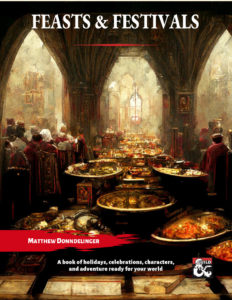The Challenge: Barbarian
As I noted before, my wife and I are trying to play all core 5e classes from levels 1 to 20. This post will focus on my experience DMing for Lithen, a level 20 barbarian. Here’s some basic information:
- Half orc berserker barbarian.
- His primary magic item was a homebrew dragon skull helmet that let him spend hit dice when he used his relentless rage ability.
- He had a cleric traveling companion who offered a lot of utility.
Some of the topics I’ll cover are continuations to what I discussed in my post on one-on-one D&D overall.
Adventures
Barbarians are fairly straightforward in the sense they can be quite combat-focused and can punch above their level thanks to rage doubling their HP against some types of enemies. Most of the adventures I created had a wilderness aspect, specifically around intense heights and harsh environments. I did this to showcase Lythan’s ability to climb (and survive a long fall) and deal with a cold or hot environment via high Constitution saving throws.
Barbarians also offer an opportunity to really lean into the one hero vs a horde of weaker foes. In 5e, typically the many weak bad guys would either get destroyed by a fireball or other AoE spell or quickly take out the heroes thanks to the action economy. Thanks to Lithen’s high HP and 3 attacks, he was able to fight against a horde of roaming raiders at fairly low level.
Characters
We found creating a compelling barbarian fairly simple since their core fantasy is pretty broad. Typical we did someone from an uncivilized culture in a harsh climate going on a quest for honor or revenge. This worked because when the character would complete their initial quest, they had been exposed to a new world and usually found something, or someone, in it that made them want to stay connected to story an setting.
We focused mainly on totem barbarians just because my wife likes animals and we found they are even stronger in solo gameplay because it’s harder for enemies to ignore a bear totem and attack another party member when they aren’t any other party members.
The Social Pillar
Somewhat obviously, there was limited social content in Lithen’s game given his low mental stats, it didn’t seem fun to force my wife to try overcoming social challenges. I didn’t let her off easy and politics were still a part of the game, but the focus was on using physical and combat abilities to overcome social conflicts. One example is when she was trying to convince other orcish warlords to work together. They asked him to prove his might and why they should follow him, being a high-level character, that was relatively easy. I think this advance will hold for most unsocial characters. Enforce consequences for low charisma, but don’t force them to try and fail. Just provide an alternative. It’s fun for players to use their strengths to overcome weaknesses.
The Combat Pillar
As much as Lihen was ill-suited to the social pillar, he excelled at combat. The biggest challenge I faced was figuring out how to make interesting combats that didn’t feel similar. In a group setting, you have more combatants on each side, and they tend to more varied abilities. This naturally creates some variance in combat encounters. In a solo game, you have fewer combatants and this creates less variance. Combine this with a class that already struggles with “I hit it” syndrome and you risk a boring campaign. Not all players will find this boring, but some might, and my wife did struggle at points when she felt she didn’t have many in-combat options. I wish I could tell you how I fixed the problem and my perfect solution, but I didn’t find one. I used terrain the best I could and obviously different kinds of monsters, but it always felt like it could be better.
The Exploration Pillar
Exploration was an unexpected highlight of the game. With a barbarian’s high strength and constitution, I was able to design some interesting mountain encounters centered around climbing and surviving in the cold. Because of where the story ended up going, I think there was a lot we could have done, but didn’t get a chance to.
My big takeaway is that you need to provide alternative solutions for problems characters aren’t equipped to handle, but you need to present the challenge and force them to rely on their strengths.
Lithen was forced to roll saving throws because he didn’t have enough food and water, but he was able to survive anyway because of his high Constitution.
NPCs & Magic Items
Magic items were one of the best parts of this game. As I mentioned in How to Run Solo D&D when giving out magic items or special powers, we tend to two options: widen or deepen a character’s capabilities or strengths. In Lihen’s case, I could have given him a magic item that increased his damage or hit points (two existing strengths) or I could have given him a way to create spell like effects. This led to one of my wife and I’s favorite magic item. Lithen’s helmet made from a white dragon he killed. It allowed him to spend hit dice and frighten creatures when he used relentless rage. His means he got to survive deadly encounters against hordes of monsters, effectively giving them an area of effect spell. Because it was fueled by his relentless rage, it meant that my wife was rewarded for being good at being a barbarian
